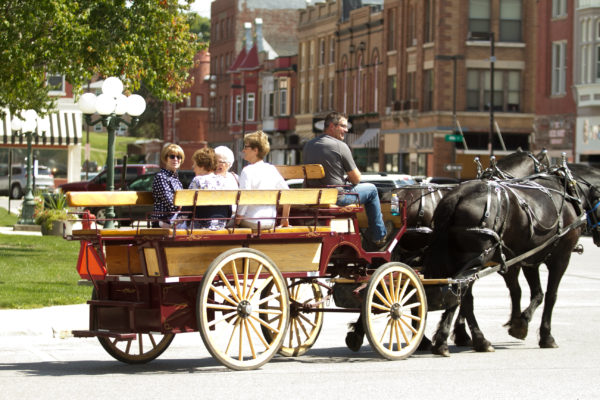By Ashley Rullestad

A horse-drawn carriage transports patrons of Red Oak’s home and tea tour. Photo by Laura Kloewer, courtesy of Red Oak Chamber & Industry Association
Located in Iowa’s southwest corner in Montgomery County, Red Oak is a town with a rich history in military, railroads and calendars. It derives its name from Red Oak Creek, which flows through the community and is named for the red oaks on its banks. The first settlers there arrived in the mid-1850s.
Red Oak became the official county seat of Montgomery County in 1865. The county was formed in 1851 and named after Revolutionary War hero, Richard Montgomery. It was in those early days that the county experienced rapid growth, with its peak population of 17,803 recorded in the 1900 U.S. census.
The railroad arrived in Red Oak in 1869, and that’s when the town’s growth began to boom. With the arrival of the railroad, Red Oak became a frenzy of activity. The population of Montgomery County tripled in size between 1870 and 1880. Red Oak became the trade center for the area with industries such as meat-packing, a brewery, a glove factory, buggy manufacturing, a cannery, flour mills and a brick-and-tile works.
Today, visitors can experience Red Oak’s impressive collection of turn-of-the-century homes by taking the Historic Heritage Hill Tour, which reflects the wealth the railroad brought to the area from the 1870s to 1916. Because of the railroad, luxury building materials like stone, marble and granite could be delivered more easily from other parts of the country. The size of the home made a statement as to the financial success of the owner and everyone wanted to be seen as the biggest and the best.
Red Oak has a proud military history. It is said that in the American Civil War, the area provided more Union troops per capita than any other in the state. During World War I, Red Oak’s Company M went to the front lines with a full strength of 250 men. After brave fighting, Company M suffered a staggering 160 casualties with 52 soldiers killed in action.
TO READ THE ENTIRE STORY AND OTHER FASCINATING STORIES ABOUT IOWA HISTORY, subscribe to Iowa History Journal. You can also purchase back issues at the store.
